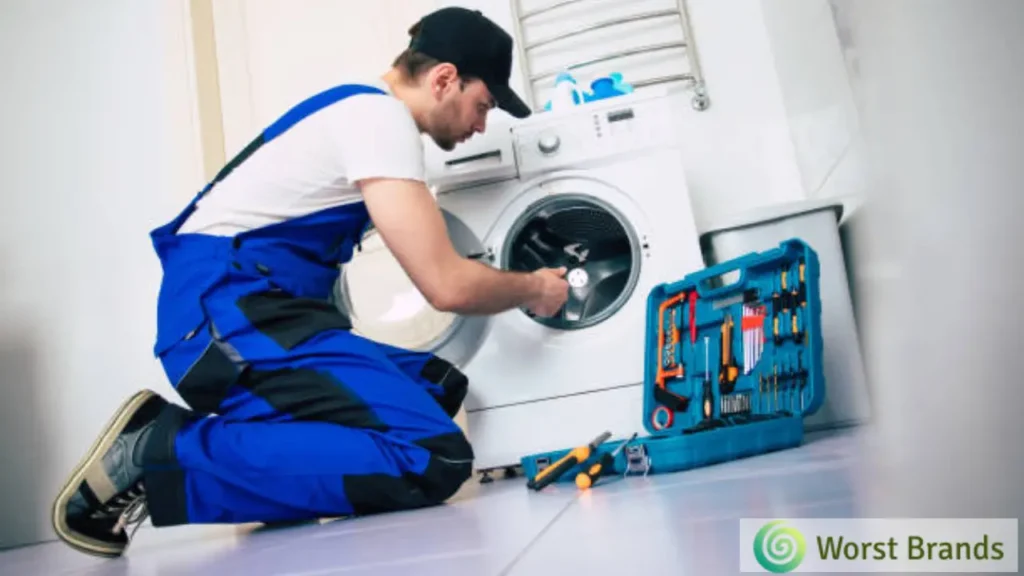There’s nothing quite as infuriating as a washing machine that refuses to empty its water. A drum full of wet clothes and standing water is the last thing anyone needs.
If you are a Whirlpool washer owner, you might have encountered this problem. But fret not; this, along with the Whirlpool washer not spinning, are common issues that often don’t require professional intervention.
I have prepared a list of common reasons behind your Whirlpool washer not draining and provide a detailed and easy manual on how to rectify it.

Table of Contents
- Why Your Whirlpool Washer is Not Draining?
- Clogged Drain Pipe or Hose
- Defective Drain Pump
- Impeded Coin Trap
- Faulty Lid Switch Assembly
- 5 Easy Steps to Repair Whirlpool Washer Won’t Drain Issue
- Step 1: Disconnect the Washer
- Step 2: Clean the Drain Pipe and Hose
- Step 3: Inspect the Drain Pump
- Step 4: Substitute the Lid Switch Assembly
- Step 5: Cleanse the Coin Trap
- Step 6: Reassemble the Washer
- Additional Tips to Prevent Whirlpool Washer Draining Issue
- Consistent Cleaning of the Lint Filter
- Avoid Overloading Your Washer
- Routine Inspection of the Drain Pipe
- Regular Assessment of the Drain Pump
- Conclusion
- Crystal Hafley
Why Your Whirlpool Washer is Not Draining?
Various factors could be contributing to your Whirlpool washing machine not draining. Here are some prevalent ones:
Clogged Drain Pipe or Hose
Lint, small pieces of fabric, and other detritus can accumulate in the drain pipe over time, leading to an obstruction.
Defective Drain Pump
The drain pump plays a crucial role in expelling water from the washer. If it’s compromised or malfunctioning, drainage complications may arise.
Impeded Coin Trap
The coin trap, or debris filter, is a section of the washer designed to prevent foreign objects from reaching the drain pump.
If items like coins, hairpins, or buttons get trapped, they can impede water flow and prevent drainage.
Faulty Lid Switch Assembly
The lid switch assembly is a critical safety component that halts the washer’s operation when the lid is open.
A defective lid switch assembly can hinder the washer’s draining process.
5 Easy Steps to Repair Whirlpool Washer Won’t Drain Issue
Having identified the root cause of the washer drainage issue, it’s time to roll up your sleeves and start the repair work.
Follow my comprehensive yet straightforward guide to fix your Whirlpool washer failing to drain problem.
But before diving in, the following table provides some easy fixes for common washer draining problems.

Step 1: Disconnect the Washer
Before embarking on any repair work, ensuring your safety is paramount.
Start by disconnecting the washer from the electrical outlet. This step is crucial to avoid any potential electric shocks while working on the machine.
Step 2: Clean the Drain Pipe and Hose
The drain pipe can often be a culprit behind drainage issues. Over time, it can accumulate debris, lint, and even small pieces of clothing.
If you’ve determined that the drain pipe or hose is obstructed, carefully detach it from the washer.
Next, thoroughly clean it with running water and use a long brush to remove any accumulated debris. Ensure that water flows freely through the pipe before reattaching it.
Step 3: Inspect the Drain Pump
The drain pump is essential for expelling water from the washer. If it’s compromised, it will hinder the draining process, and sometimes, it will not unlock the Whirlpool washer door.
Carefully examine the drain pump for any visible signs of damage, such as cracks or leaks. Listen for any unusual noises that might indicate internal damage.
If the drain pump is found to be defective, it must be replaced. Order the exact replacement part specified in your washer’s user manual.
Step 4: Substitute the Lid Switch Assembly
The lid switch assembly is a safety mechanism that prevents the washer from operating with the lid open.
A malfunctioning lid switch assembly can interrupt the draining process. Listen for a clicking sound when closing the lid to test its functionality.
If you do not hear a click or the washer doesn’t start its cycle with the lid closed, the lid switch assembly likely needs replacing.
Obtain the correct replacement part as specified in your washer’s user manual and replace the faulty assembly.
Step 5: Cleanse the Coin Trap
The coin trap, or debris filter, captures foreign objects like coins, hairpins, or buttons and prevents them from entering the drain pump.
Over time, these objects can accumulate and obstruct water flow.
If you’ve diagnosed that the coin trap is impeded, carefully remove the foreign objects causing the obstruction.
Be thorough in your cleaning to ensure no small items are left behind.

Step 6: Reassemble the Washer
Once you have addressed the issue and replaced any faulty components, it’s time to reassemble the washer.
Make sure to securely reconnect all the parts that were removed during the repair process. Finally, reconnect the washer to the electrical outlet.
Additional Tips to Prevent Whirlpool Washer Draining Issue
To ensure the smooth operation of your Whirlpool washer and prevent recurrent drainage complications, it’s essential to adopt certain maintenance habits.
Here are some key preventive measures to incorporate into your routine:
Consistent Cleaning of the Lint Filter
The lint filter is crucial in capturing lint and tiny debris shed from your clothes during a wash cycle.
Over time, this debris can accumulate, causing the filter to clog and impede water flow.
Make it a habit to clean the lint filter regularly. Consult your washer’s user manual for instructions on accessing and cleaning the lint filter, as the location may vary from model to model.
Avoid Overloading Your Washer
Overloading the washer not only affects the quality of the wash but can also lead to drainage problems.
An excessive load can strain the drain pump, causing it to malfunction over time.
Always adhere to the manufacturer’s guidelines regarding the maximum load capacity of your washer.
Distribute clothes evenly to prevent imbalance and ensure optimal performance.
Routine Inspection of the Drain Pipe
The drain pipe is another common area where obstructions can occur. Regularly inspect the drain pipe for any kinks, bends, or blockages.
If you notice any debris accumulated in the pipe, remove it promptly to ensure smooth water flow.
It’s also advisable to periodically detach the drain pipe and flush it with water to remove any lingering debris.
Check out our following blogs to fix the draining problems of other popular washing machine brands:
- How to Fix Hotpoint Washing Machine Not Draining?
- Beko Washing Machine Not Draining – Issue Solved
- 7 Reasons Why Maytag Washer Not Draining Water
Regular Assessment of the Drain Pump
The drain pump is vital for expelling water from the washer. Regularly check the drain pump for any signs of wear and tear or damage.
Listen for unusual sounds during the drain cycle, which could indicate a problem.
If you notice any abnormalities, it’s advisable to seek professional help or replace the drain pump if necessary.
Conclusion
A Whirlpool washer not draining can be a frustrating issue, but with a little effort and some basic tools, you can diagnose and fix the issue yourself.
Always unplug the washer before you start working on it, and follow the manufacturer’s instructions carefully.
If you are not comfortable fixing the washer yourself, it is always a good idea to call a professional for help.

Crystal Hafley is a dedicated writer and content creator for WorstBrands, where she specializes in writing insightful reviews about kitchen appliances and fashion products.
With her expertise, Crystal provides readers with accurate and reliable information to help them make informed decisions about the brands and products they use every day. When she's not researching or writing, Crystal enjoys cooking and exploring the latest fashion trends.